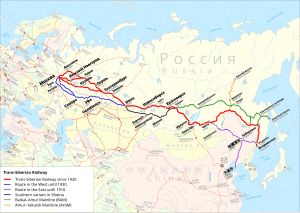Trans-Siberian Railway
As of 2021[update], expansion projects remain underway, with connections being built to Russia's neighbors Mongolia, China, and North Korea.[4] The railway is often associated with the main transcontinental Russian line that connects many large and small cities of the European and Asian parts of Russia.[10] The main route begins in Moscow at Yaroslavsky Vokzal, runs through Yaroslavl or Chelyabinsk, Omsk, Novosibirsk, Krasnoyarsk, Irkutsk, Ulan-Ude, Chita, and Khabarovsk to Vladivostok via southern Siberia.[12] One of the first was the Irkutsk–Chita project, proposed by the American entrepreneur Perry Collins and supported by Transport Minister Constantine Possiet with a view toward connecting Moscow to the Amur River, and consequently the Pacific Ocean.By 1880, there was a large number of rejected and upcoming applications for permission to construct railways in order to connect Siberia with the Pacific, but not Eastern Russia.However, due to the swampy banks of the Ob River near Tomsk (the largest settlement at the time), the idea to construct a bridge was rejected.[17][18] The Russian admiral and explorer Stepan Makarov (1849–1904) designed Baikal and Angara but they were built in Newcastle upon Tyne, by Armstrong Whitworth.This measure changed the nature of export: mills emerged to produce bread from grain in Altai Krai, Novosibirsk and Tomsk, and many farms switched to corn (maize) production.[23] Historian Christian Wolmar argues that the railroad was a failure, because it was built for narrow political reasons, with poor supervision and planning.Wolmar concludes: The railway, which was single track throughout, with the occasional passing loop, had, unsurprisingly, been built to a deficient standard in virtually every way.The permanent way was flimsy, with lightweight rails that broke easily, insufficient ballast, and railroad ties often carved from green wood that rotted in the first year of use.The intervention was weakened, and ultimately defeated, by partisan fighters who blew up bridges and sections of track, particularly in the volatile region between Krasnoyarsk and Chita.[25] The leader of legions politician Milan Rastislav Stefanik[26] traveled from Moscow to Vladivostok in March to August 1918, on his journey to Japan and the United States of America.[29] At the same time, a number of Jews and anti-Nazis used the Trans-Siberian Railway to escape Europe, including the mathematician Kurt Gödel and Betty Ehrlich Löwenstein, mother of British actor, director and producer Heinz Bernard.[citation needed] Accordingly, it accounted for as much freight as the North Atlantic–Arctic and Iranian routes combined, though cargoes were limited to raw materials and non-military goods.From 1941 to 1942 the TSR also played an important role in relocating Soviet industries from European Russia to Siberia in the face of the German invasion.When an Anglo-American delegation visited Moscow in October 1944 to discuss the Soviet Union joining the war against Japan, Alanbrooke was told by General Antonov and Stalin himself that the line capacity was 36 pairs of trains per day, but only 26 could be counted on for military traffic; see Pacific Route.[34] Although the Japanese estimated that an attack was not likely before Spring 1946, Stavka had planned for a mid-August 1945 offensive, and had concealed the buildup of a force of 90 divisions; many had crossed Siberia in their vehicles to avoid straining the rail link.[38] On January 11, 2008, China, Mongolia, Russia, Belarus, Poland, and Germany agreed to collaborate on a cargo train service between Beijing and Hamburg.There is no direct passenger service along the entire original Trans-Manchurian route (i.e., from Moscow or anywhere in Russia, west of Manchuria, to Vladivostok via Harbin), due to the obvious administrative and technical (gauge break) inconveniences of crossing the border twice.






Trans-Siberian (disambiguation)Lake BaikalRussianGovernment of RussiaMoscow YaroslavskyVladivostokRegionalcommuterfreightV-SibZhDZ-SibZhDKrasZhDZabZhDRussian RailwaysTrack gauge1,520 mmElectrification3 kV DC25 kV 50 Hz ACoverhead lineYaroslavskyTerminalKhotkovoSergiyev PosadGreater Ring of the Moscow RailwayMoscow OblastVladimir OblastYaroslavl OblastRostov-YaroslavskyYaroslavlYaroslavl-GlavnyVologdaArkhangelskKostroma OblastGalichManturovoVetlugaSharyaKirov OblastNizhny NovgorodKotelnichVyatkaUdmurtia25 kV 50 Hz ACCheptsaPerm KraiSverdlovsk OblastPervouralskYekaterinburgBogdanovichKamyshlovTalitsaTyumen OblastTyumenYalutorovskZavodoukovskOmsk OblastNazyvayevskIrtyshKalachinskNovosibirsk OblastTatarskBarabinskChulymNovosibirskBolotnayaKemerovo OblastAnzhero-SudzhenskMariinskKrasnoyarsk KraiBogotolAchinskKrasnoyarskYeniseyZaozyornayaIlanskayaIrkutsk OblastTayshetBaikal–Amur MainlineNizhneudinskUst-OrdynskyCheremkhovoUsolye-SibirskoyeAngarskIrkutskKultukSlyudyankaBaykalskBuryatiaSelengaUlan-UdeTrans-Mongolian RailwayZabaykalsky KraiPetrovsk-ZabaykalskyKhilokChinese Eastern RailwayShilka-PassNerchinskSretenskMogochaAmur OblastAmur–Yakutsk MainlineSkovorodinoMagdagachiShimanovskayaSvobodnyBelogorskBlagoveshchenskJewish Autonomous OblastObluchyeBirobidzhanKomsomolsk–Dezhnyovka railway lineKomsomolsk-on-AmurJewish Aut. OblastKhabarovsk KraiKhabarovskVyazemskayaPrimorsky KraiDalnerechenskLesozavodskSpassk-DalnyUssuriyskBaranovskyBaranovsky–Khasan lineKhasanNakhodka
